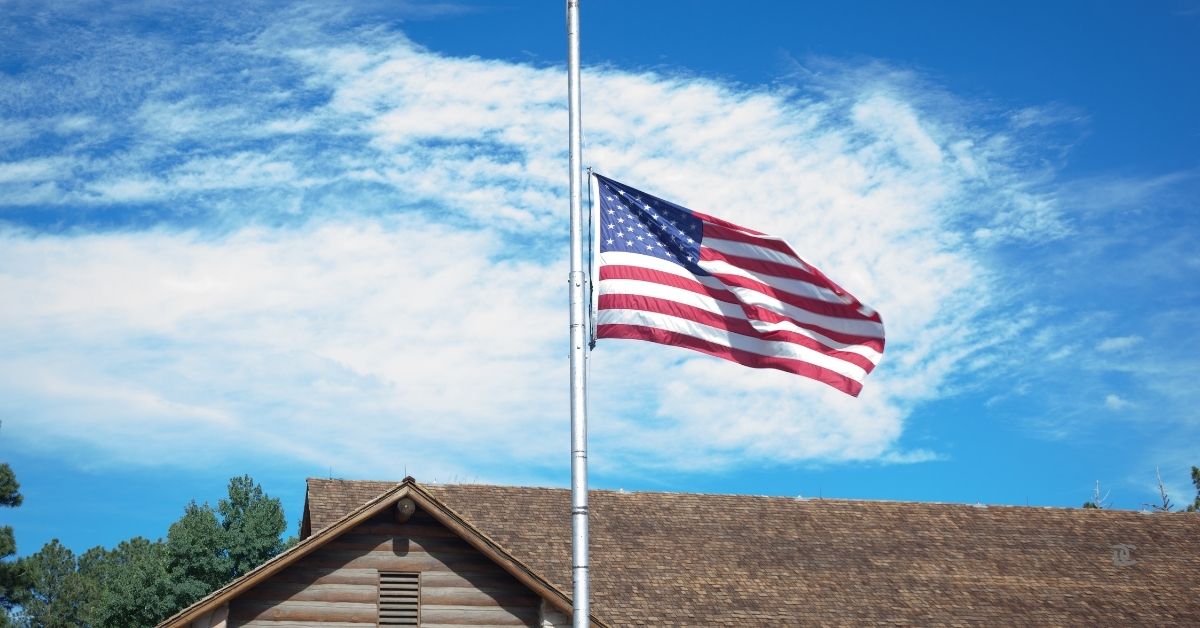The nation is coming together to honor the life and legacy of former President Jimmy Carter, who passed away in his hometown of Plains, Georgia, on December 29th at the remarkable age of 100. As we reflect on his contributions and celebrate his life, flags across the country continue to fly at half-staff in remembrance of this esteemed leader.
The Half-Staff Flag Protocol
The half-staff flag protocol is a set of guidelines and traditions for displaying the U.S. flag at half-staff (or half-mast, the terms are often used interchangeably, though “staff” is generally preferred on land) as a symbol of mourning and respect.
Purpose
- It’s a visible sign of mourning for significant figures or national tragedies.
- It shows respect for the deceased and their contributions.
- It unites the nation in a shared moment of remembrance.
Who Orders It?
- The President: The President of the United States has the authority to order flags to be flown at half-staff nationwide. This is typically done upon the death of:
- Presidents and former Presidents
- Vice Presidents, Chief Justices, and other high-ranking government officials
- Other individuals deemed worthy of national recognition
- Governors: Governors can order flags to be flown at half-staff within their respective states.
How to Display the Flag
- Hoist to Peak First: The flag should always be raised to the top of the pole for a moment before being lowered to the half-staff position. This applies both when initially lowering it and when taking it down at the end of the day.
- Half-Staff Position: There’s no precise measurement for “half-staff.” Generally, it means the flag should be lowered to a position halfway between the top and bottom of the pole. A good rule of thumb is to position the center of the flag midway between the top of the pole and the ground.
- Memorial Day Exception: On Memorial Day, the flag is flown at half-staff until noon only, then raised to the top for the remainder of the day.
In the case of President Jimmy Carter, this gesture honors his service as the 39th President of the United States from 1979 to 1981, as well as his lifelong dedication to humanitarian efforts and peacekeeping around the world.
How Long Will Flags Fly at Half-Staff?
In recognition of President Carter’s passing, President Joe Biden has declared Thursday, January 9th, as a national day of mourning. On this day, most federal workers will have a day off to honor Carter’s memory. Additionally, flags will be displayed at half-staff for a total of 30 days starting from the day of his death on December 29th. This includes:
Also Read
- The White House: All flags at the White House will be lowered to half-staff.
- Public Buildings and Grounds: Federal buildings and public spaces across the country will also honor President Carter by flying their flags at half-staff.
- Military Posts: Flags at all military installations will be lowered to half-mast, and naval vessels will follow suit over water.
- Private Citizens and Companies: Individuals and private organizations are encouraged to show their respect by flying their flags at half-staff during this period.
The duration of the half-staff period varies depending on the individual being honored:
- President or former President: 30 days from the day of death.
- Vice President, Chief Justice, Speaker of the House: 10 days from the day of death.
- Associate Justice of the Supreme Court, Cabinet Secretary, former Vice President, Governor: From the day of death until interment.
- Member of Congress: On the day of death and the following day.
Jimmy Carter’s Funeral and Memorial Plans
President Carter’s funeral arrangements reflect the deep respect and admiration he garnered throughout his life. Here’s a glimpse into the planned ceremonies:
- Lying in Repose: Following his passing, President Carter’s remains were laid in repose at the Carter Presidential Center in Plains, Georgia. This allowed friends, family, and admirers to pay their respects in a place that holds significant personal meaning.
- Lying in State: The journey then took his remains to Washington, D.C., where they lay in state at the United States Capitol Rotunda from January 8th to January 9th. This honor allowed the public to pay their respects and celebrate his enduring legacy.
- National Funeral Service: On January 9th, a national funeral service will be held at the Washington National Cathedral. This solemn ceremony will bring together dignitaries, government officials, and members of the Carter family to honor his life and achievements.
- Final Resting Place: After the national service, President Carter’s remains will be transported back to Plains, Georgia, where a private funeral service will be conducted. This final farewell will allow close family and friends to commemorate his life in the tranquility of his hometown.
While the formal ceremonies are being planned and executed, there are several ways you can honor President Carter’s memory:
- Fly the Flag at Half-Staff: If you haven’t already, consider lowering your flag to half-staff as a mark of respect. This small gesture is a meaningful way to show your appreciation for his contributions.
- Attend Memorial Events: Keep an eye out for public memorial events and services in your area. Participating in these gatherings can provide a sense of community and collective remembrance.
- Support Carter’s Legacy: President Carter was known for his humanitarian efforts and advocacy for peace. Consider supporting causes that align with his values, such as organizations focused on conflict resolution, human rights, and public health.
Jimmy Carter’s life was a testament to resilience, compassion, and unwavering dedication to making the world a better place. From his time in the White House to his extensive work with The Carter Center, his impact has been felt both nationally and internationally. As flags continue to fly at half-staff, we honor not just his presidency, but his enduring legacy of service and humanity.
The passing of President Jimmy Carter marks the end of an era, but his legacy will continue to inspire generations to come. As we navigate this period of mourning, let us come together to celebrate his remarkable life and the positive changes he championed. Whether through flag displays, attending memorial services, or supporting his ongoing humanitarian efforts, there are numerous ways to honor a man who dedicated his life to the service of others.






